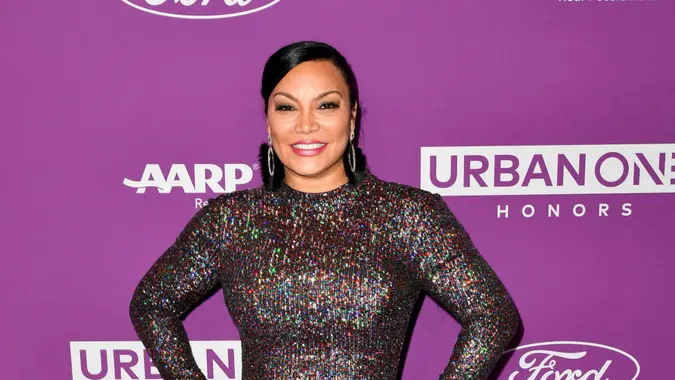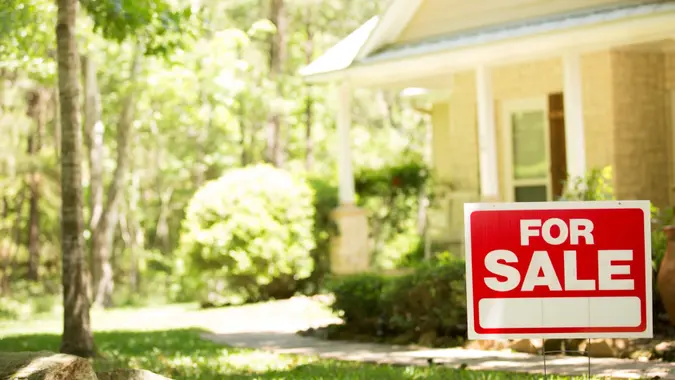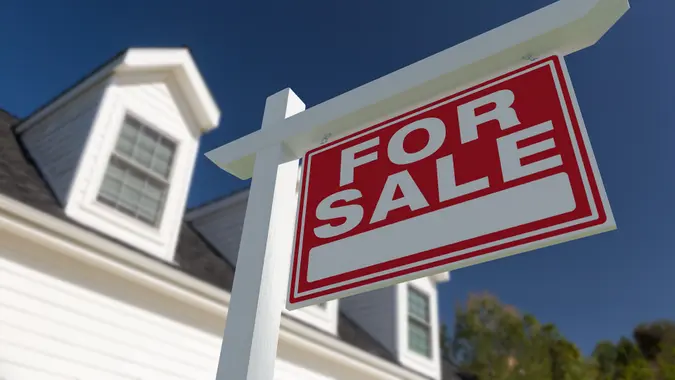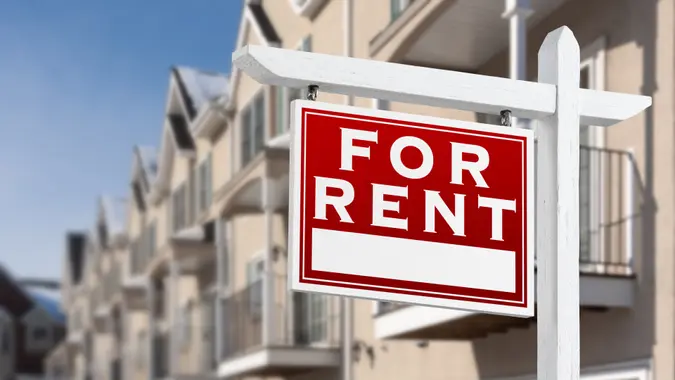How Much Should You Save for a Down Payment on a House?

Commitment to Our Readers
GOBankingRates' editorial team is committed to bringing you unbiased reviews and information. We use data-driven methodologies to evaluate financial products and services - our reviews and ratings are not influenced by advertisers. You can read more about our editorial guidelines and our products and services review methodology.

20 Years
Helping You Live Richer

Reviewed
by Experts

Trusted by
Millions of Readers
What is a Down Payment?
A down payment is a borrower’s upfront contribution to a loan that finances a big-ticket purchase like a car or house. Most lenders require one because it reduces their risk and demonstrates the borrower’s commitment and capacity to repay the loan. On the other hand, a down payment benefits buyers by reducing the amount they need to finance the purchase and serving as an equity deposit.
Typical Down Payment Amounts
The standard down payment for a conventional loan is 20%–that’s $40,000 for a $200,000 home or $100,000 for a $500,000 property.
Many lenders still require borrowers to put down one dollar in five, but others will accept 10%, 5% or even 3%, depending on the loan and your overall financial situation. Also, the government backs certain kinds of loans for certain kinds of borrowers for low or even no money down.
Factors That Affect Your Down Payment
Several key variables impact what the correct down payment is for each unique buyer and property transaction.
- Your credit score: Lenders often require lower-credit borrowers to put more money down.
- Your debt-to-income ratio: Larger down payments are typically required for borrowers who have too much debt relative to their income. The 28/36 rule — which is a guideline, not an actual rule — says that housing costs should account for no more than 28% of your monthly income and all combined debt should stay under 36%.
- Loan type: Down payments for conventional loans typically require 3% to 20% down. Government-backed FHA loans require as little as 3.5% down. The FDA and VA offer zero-money-down loans to qualified buyers.
- Home price and location: Lenders also consider the property itself, including its local real estate market and its value.
How to Calculate Your Down Payment
You can calculate your down payment by multiplying your savings by the percentage you hope to put down or by figuring the percentage of the home you hope to buy.
Consider the following examples:
- A buyer with $30,000 wants to put 20% down to avoid paying mortgage insurance, which means the price limit is $150,000.
- The same buyer with the same $30,000 falls in love with a $500,000 home and, therefore, must find a lender willing to accept a 6% down payment.
Free online calculators make it easy to run the numbers for your unique situation.
| Home value | Down payment | Percentage | Percent and amount financed |
| $150,000 | $30,000 | 20% | 80% ($120,000) |
| $500,000 | $30,000 | 6% | 94% ($470,000) |
Alternatives to a Traditional 20% Down Payment
Buyers have to come up with $71,000 to put the standard 20% down for a $355,000 home, which Zillow cites as the current average 2025 U.S. home value. That’s too high a hill to climb for many buyers, who might consider the following alternatives.
- Conventional loans that accept less — with some, it’s as little as 3%.
- FHA loans require as little as 3.5% down and are available to lower-credit borrowers.
- VA loans offer qualifying military personnel and veterans access to 0% down loans.
- The USDA offers 0% down loans to rural buyers who meet certain income requirements.
- State-based and nonprofit programs offer down payment assistance to eligible first-time homebuyers.
While too large a down payment can gobble up your savings, increase the upfront costs and tie up too much of your wealth in hard-to-tap equity, bigger is often better.
Benefits of Making a Larger Down Payment
There are several reasons why bigger down payments can put homeowners in an advantageous position.
- Lower monthly payments
- Reduced interest rates
- Less interest paid over the life of the loan
- With 20% or more down, there’s no need to purchase private mortgage insurance (PMI)
- The bigger the down payment, the less risk you pose to lenders
- Sizeable down payments can mitigate shaky credit
How to Save for a Down Payment
Save for a down payment the same way you would for any other major financial goal or milestone.
- Establish a separate savings bucket just for your down payment.
- Schedule automated transfers to put your savings on autopilot and set alerts to monitor your progress.
- Cut back on non-essential expenses and contribute every possible dollar without straining your finances.
- Research and apply for all down payment assistance programs for which you’re eligible.
Common Mistakes to Avoid When Making a Down Payment
Just as there are strategies to make saving for a down payment as quick and painless as possible, there are pitfalls to avoid that could prolong your timeline or even foil your plans to buy a home.
- Dumping all your savings into your down payment at the expense of an emergency fund
- Failing to calculate the many associated home-buying costs beyond the sale price, including closing costs, taxes, insurance, maintenance and repairs.
- Rushing to buy before your finances are in order.
Our in-house research team and on-site financial experts work together to create content that’s accurate, impartial, and up to date. We fact-check every single statistic, quote and fact using trusted primary resources to make sure the information we provide is correct. You can learn more about GOBankingRates’ processes and standards in our editorial policy.
- Freddie Mac. "Maximum LTV/TLTV/HTLTV Ratio Requirements for Conforming and Super Conforming Mortgages."
- Fannie Mae. 2021. "ELIGIBILITY MATRIX."
- Rocket Mortgage. 2022. "What Is PMI? Private Mortgage Insurance Defined And Explained."
- Chase. "What is PMI and how is it calculated?"
- Congressional Research Service. 2022. "FHA-Insured Home Loans: An Overview."
- U.S. Department of Veterans Affairs. 2022. "VA funding fee and loan closing costs."
- American Financing. "Buying a Home with Bad Credit and a Big Down Payment."
 Written by
Written by  Edited by
Edited by 

























